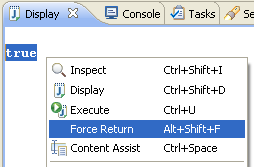Force Return
Select the Force Return command to return from the current method with the speified value.
You can force an early return from a method (only
available when debugging on a Java SE 6 virtual machine). This returns
a value from the current stack frame without executing any more instructions
in the method and releases any locks obtained by synchronized blocks.
A return value is created by selecting an expression and Force
Return (Alt+Shift+F). This action is available
from the Java editor's context menu, top level
Run menu, in the
Display View, and in the
detail pane
of the
Variables View.
Forcing an early return from a non-void method requires an expression
to be evaluated. For example, if a method was going to return false
you could return a value of true by selecting an expression in the Display
View and invoking Force Return. In the following example, elementCount is not equal to zero, and would return false
(see debug hover showing the value of elementCount).

From the Display View, we could enter the value we want returned, select it and use the Force Return command to force the method isEmpty() to return with that value (in the following example we will force isEmpty() to return with the value true).

This command applies to:

Evaluating Expressions
